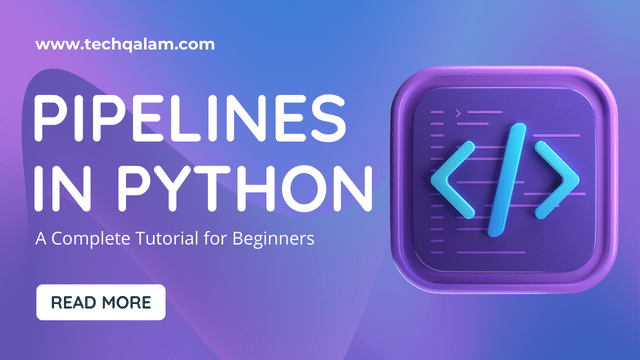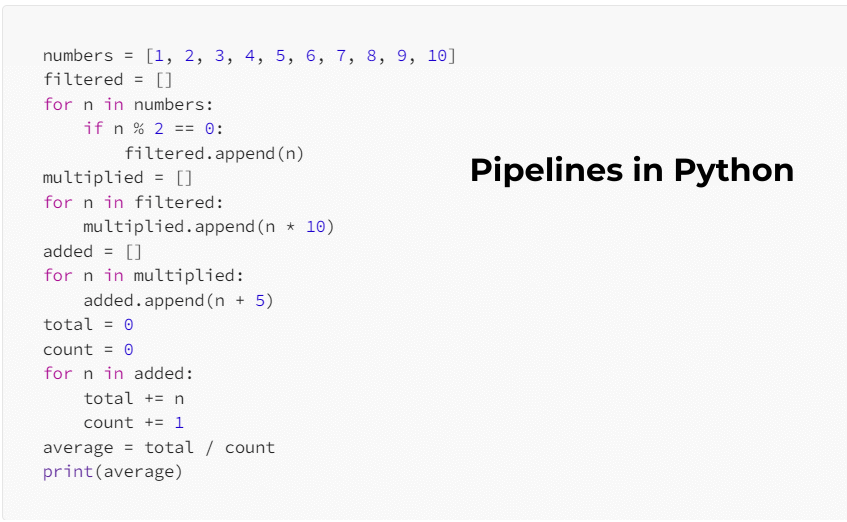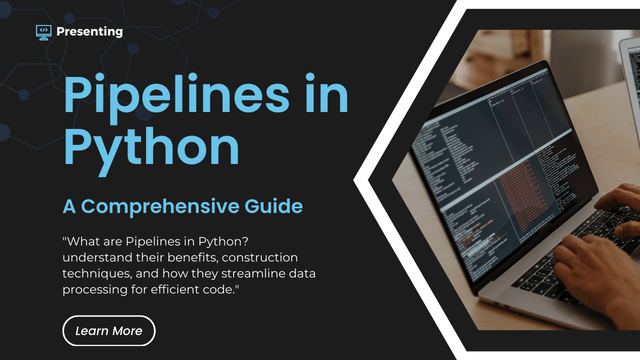What are Pipelines in Python?: A Comprehensive Guide
Introduction
For those acquainted with Python development, the notion of a “pipeline” likely rings familiar. Yet, what precisely constitutes a pipeline and what merits does it offer?

This blog entry aims to delve into the realm of pipelines in Python, elucidating their functionality, operational mechanisms, and their pivotal role in enabling the creation of code that is both more streamlined and proficient.
What is a Pipeline?
The concept of a pipeline revolves around structuring a sequence of operations or functions designed to handle data. Each operation takes the output from the preceding one as its input, forming a continuous flow until reaching the ultimate outcome.
Imagine a series of interconnected pipes—data moves through these pipes, undergoing various alterations or manipulations at each stage.
Consider a scenario where you possess a list of numbers and aim to execute the following tasks:
1. Remove the odd numbers.
2. Multiply each number by 10.
3. Add 5 to every number.
4. Compute the average of the resulting numbers.
One approach involves employing a loop that traverses the list, executing each task sequentially and preserving the interim outcomes in a fresh list. For instance:

While the provided code functions, it lacks elegance and efficiency. It generates three additional lists, consuming memory and compromising code readability. Moreover, it necessitates the creation of four separate loops, prone to tedium and errors.
A superior approach involves leveraging a pipeline structure. Pipelines enable seamless chaining of operations without the need for intermediate lists or multiple loops.
This can be achieved using the built-in functions like ‘map and filter', which accept a function and an iterable as parameters, returning a new iterable by applying the function to each element. Additionally, functions like ‘sum and len' come in handy for calculating the sum and length of an iterable. For instance:

This revised code, while notably shorter and more straightforward than its predecessor, maintains a clear advantage by sidestepping the creation of new lists or loops, ensuring a seamless data flow from one operation to the next.
Nevertheless, readability remains a concern due to the nested `map and filter` calls, potentially causing confusion and hindering comprehension.
A strategy for enhancing readability involves employing the `pipe` function from the `toolz` library. This function accepts an initial value and a sequence of functions, consecutively applying each function to the output of its predecessor, culminating in the final result. For instance:

The presented code surpasses its predecessors in readability and elegance. It vividly illustrates the sequence of operations executed on the data without resorting to nested calls or intermediary lists.
The utilization of the `pipe` function notably transforms the code into a streamlined pipeline, mirroring the smooth flow of data from one function to the next.
Why Use Pipelines?
Pipelines offer multiple advantages compared to alternative code organization methods. Some of these benefits include:
1. Readability:
Pipelines enhance code readability and comprehension by clearly depicting the sequential flow of data from one operation to another. They eliminate clutter caused by intermediate variables or loops.
Additionally, pipelines promote modularity and reusability, allowing individual operations to be defined as distinct functions. This facilitates easy testing and reuse across various contexts.
2. Efficiency:
Pipelines contribute to code efficiency by sidestepping the creation of intermediate lists or iterables, preventing excessive memory consumption and accelerating execution speed.
Moreover, they facilitate lazy evaluation, executing operations only when necessary rather than beforehand. This optimization conserves time and resources, particularly when handling substantial or infinite data sources.
3. Flexibility:
Pipelines offer effortless adaptability and extension, enabling the addition, removal, or reordering of operations without impacting the remainder of the code.
They accommodate a diverse range of operations, including filtering, mapping, reducing, aggregating, grouping, sorting, and more. These operations can be flexibly combined to achieve diverse outcomes.
How to Use Pipelines in Python?
Various methods exist for constructing and utilizing pipelines in Python. Some of these approaches include:
1. Using built-in functions:
Python offers an array of built-in functions like map, filter, reduce, zip, enumerate, sorted, reversed, and more. These functions accept a function and an iterable as arguments, generating a new iterable that applies the function to each element of the original iterable.
2. Utilizing list comprehensions:
List comprehensions present a succinct and expressive means of generating lists in Python, resembling mathematical notation. They also serve as a mechanism for constructing pipelines by consecutively applying a series of operations to each element within an iterable and aggregating the results into a new list.
3. Using generator expressions:
Generator expressions, akin to list comprehensions, generate a generator object rather than a list. A generator object is an iterable that produces elements on-demand, without storing them in memory.
These expressions serve as another avenue for crafting pipelines by applying a sequence of operations to each element of an iterable and yielding the results as a generator.
I trust this blog post has provided clarity on the concept of pipelines and their application in Python. Should you have any inquiries or feedback, feel free to leave a comment below. I appreciate you taking the time to read this!
FAQs:
1. What exactly is a pipeline in Python, and how does it function?
Answer: A pipeline in Python is a sequence of operations or functions that manipulate data, where each operation uses the output of the previous one. It creates a continuous flow of data through interconnected stages, much like a series of interconnected pipes.
2. What benefits do pipelines offer compared to traditional coding methods?
Answer: Pipelines enhance code readability by illustrating the clear sequence of data operations without cluttering the code with intermediary variables or loops.
They also boost modularity and reusability by enabling each operation to be defined as a separate function, facilitating easy testing and use in various contexts.
3. How do pipelines contribute to code efficiency in Python?
Answer: Pipelines optimize code efficiency by avoiding the creation of intermediate lists or iterables, thereby preventing excessive memory usage.
They support lazy evaluation, executing operations only when required, conserving time and resources, particularly with large or infinite data sources.
4. What are the different methods for creating pipelines in Python?
Answer: Python offers various methods, including utilizing built-in functions such as map, filter, reduce, etc., list comprehensions for concise list generation with operations, and generator expressions that yield generator objects without storing data in memory.
5. How can I get started using pipelines in Python?
Answer: To begin, consider using built-in functions like map and filter, explore list comprehensions for concise operation sequencing, or experiment with generator expressions for on-demand data processing. These methods serve as foundational tools for constructing and implementing pipelines in Python.
Get access all prompts: https://bitly.com/python-in-machine-learning







